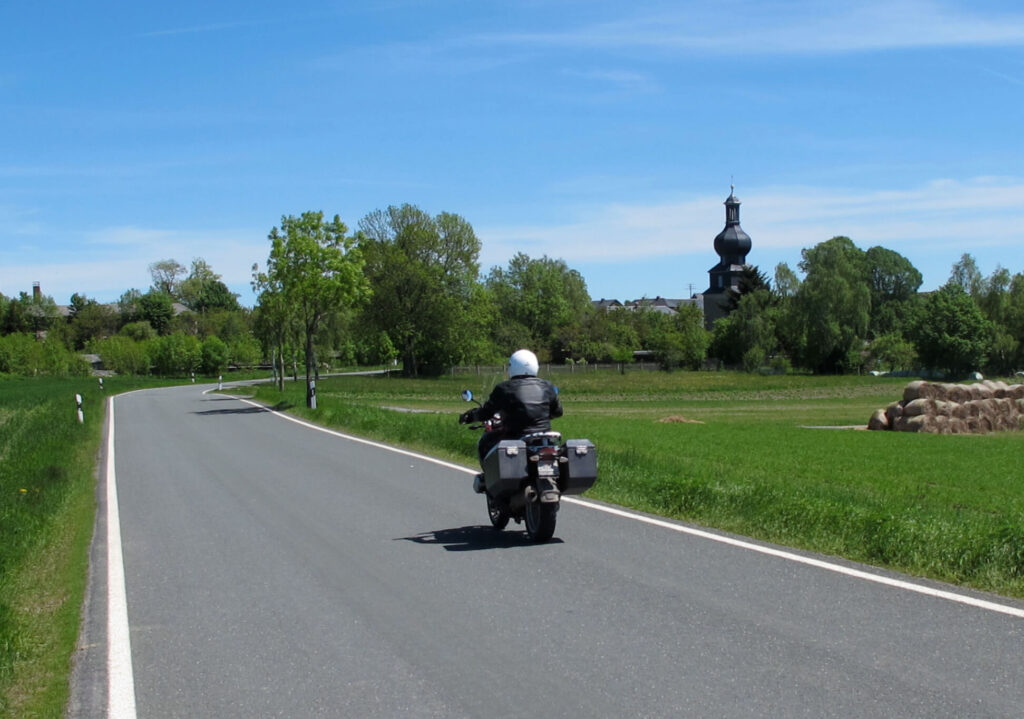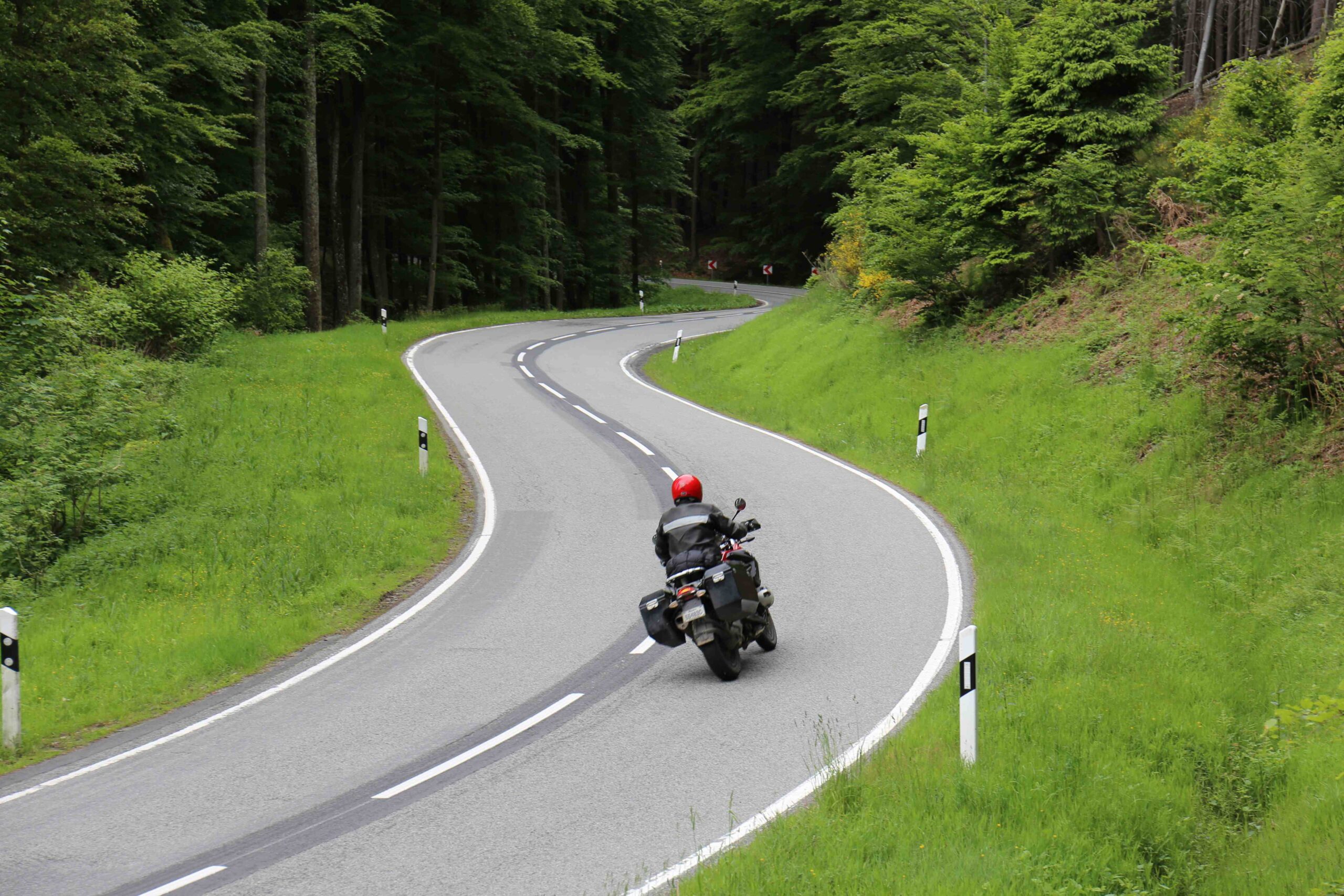
Photo by Brutus
Before our first few motorcycle rides on the Clockwork Angels tour of Britain, in May, 2013, I would ask Brutus about the next day, maybe how far the ride was. As usual, outside the U.S., he had done all the route planning, and booked the destinations. It would all be a surprise to me, and that was fine—we had traveled together like that for about seventeen years, so there were no doubts. I would simply follow the route he had programmed on my GPS—Brutus the navigator, me the helmsman.
But just as I liked to have some notion of the next day’s weather, to know how to dress (of critical importance on a motorcycle), it was good to have some idea of the shape of the ride, to know how to prepare myself mentally, and guide our pace.
However, in answer to my query, Brutus would just nod his head thoughtfully, and say, “It will be . . . a full day.”
Soon that became a joke between us, understanding that the day’s journey had nothing to do with distance. On many rides, in the mountains of Wales, Scotland, or the Yorkshire Dales, say, we could easily spend seven hours puttering around little singletrack lanes, yet with the necessarily slow pace, and frequent photo stops, we typically covered less than 200 miles in that “full day.”
That was all very well, naturally, and at the end of those long rides, several in the rain (always making a long day longer), we would settle into some luxurious country hotel, and clink our glasses with a laugh, saying, “To another full day.” Still, after ten of those full days, and five shows (at least equally “full”), I decided I would like to have an empty day.
Brutus and I were discussing what to do after the overnight ferry from Newcastle to Amsterdam. We had a rare, second day off before the show, so—where should we ride? Holland has some pretty countryside, Belgium some good riding in the Ardennes Mountains and along its rivers, and twice before Bruges had been an enjoyable destination. However, my answer was, “You know what? Let’s go . . . nowhere.”
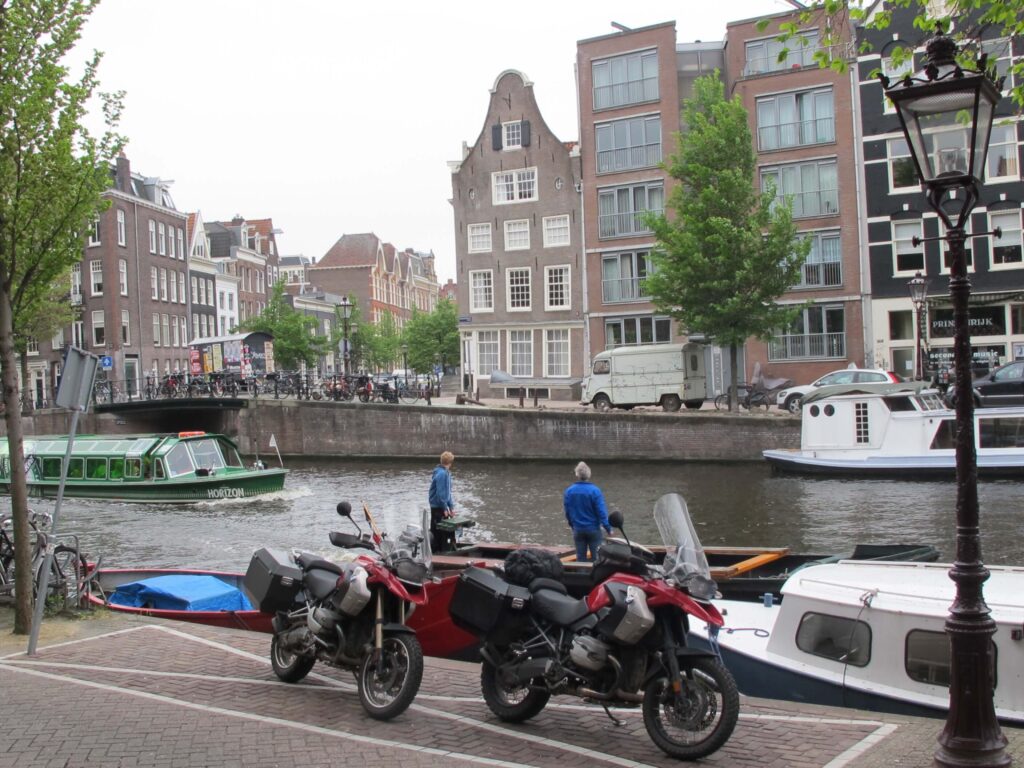
After the ferry’s morning arrival, we checked into a stylish little hotel in Amsterdam, overlooking a postcard-perfect canal, and just stayed there. The previous week, a British publication called Motorcycle News had requested something from me about riding between the U.K. shows—anything from an interview to a ride-along to a short story. Maybe 700 words, they suggested, with a photo or two. So I pecked away at that for a few hours—the only time I had ever written about a journey in the middle of it, so my impressions and memories of the highlights were sharp and alive. The story quickly grew into 1800 words and eight photographs, and I was pleased when the paper said they loved it, and would run it that way.
“Drummer With a Singletrack Mind” will appear in this department shortly after its print début. The title plays on the name Brits give to one-lane roads: “singletracks”—as in a previous story about riding in the U.K., “Singletrack Minds in the Sceptered Isle.” Brutus and I love exploring the countryside and villages on those lonely little lanes. “Shunpiking,” we call it—and although that word goes back centuries, it seems to need reviving. While working on the story, I asked an experienced British motorcyclist if riders and readers would know what shunpiking was, and I was surprised when he said they wouldn’t. At the risk of being repetitive, but at the same time happy to be a “booster” for this worthy mode of travel, I will once more share the definition from an early story collected in Far and Away, “Shunpikin’ it Old Skool.”
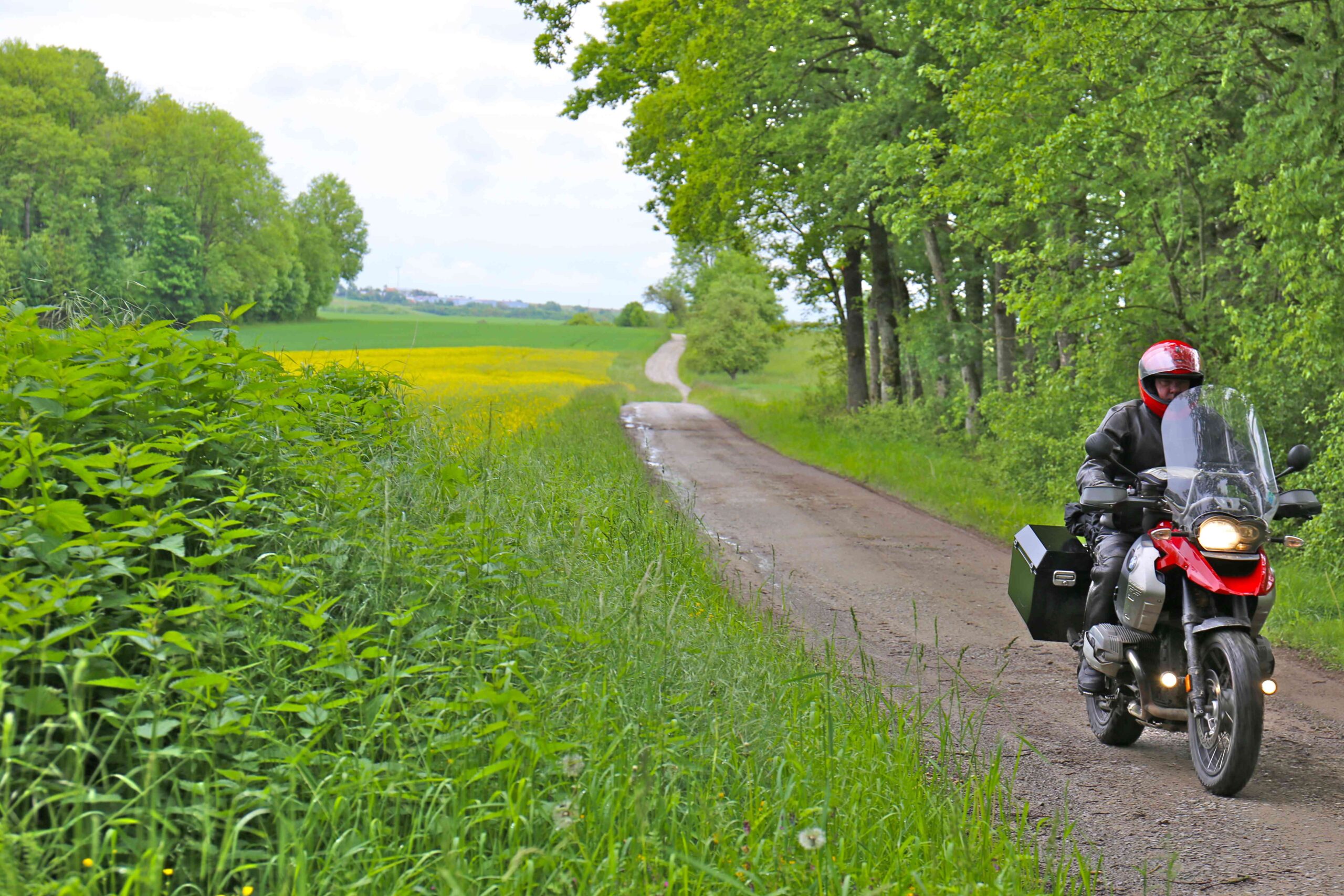
Photo by Brutus
The delightful term “shunpiker” goes back about 500 years, to a time when British roads were lawless, especially at night, prowled by highwaymen and footpads. Villages blockaded their entry roads with a long pole—a pike—stretched across them. Around the same time, toll roads were invented, and a similar pike blocked the way until travelers paid their fee, when the pike would be turned—hence “turnpike.”
In those days, travelers who deliberately avoided toll roads called themselves “shunpikers.” Lately, the term has been adopted by drivers and riders who deliberately avoid all major roads.
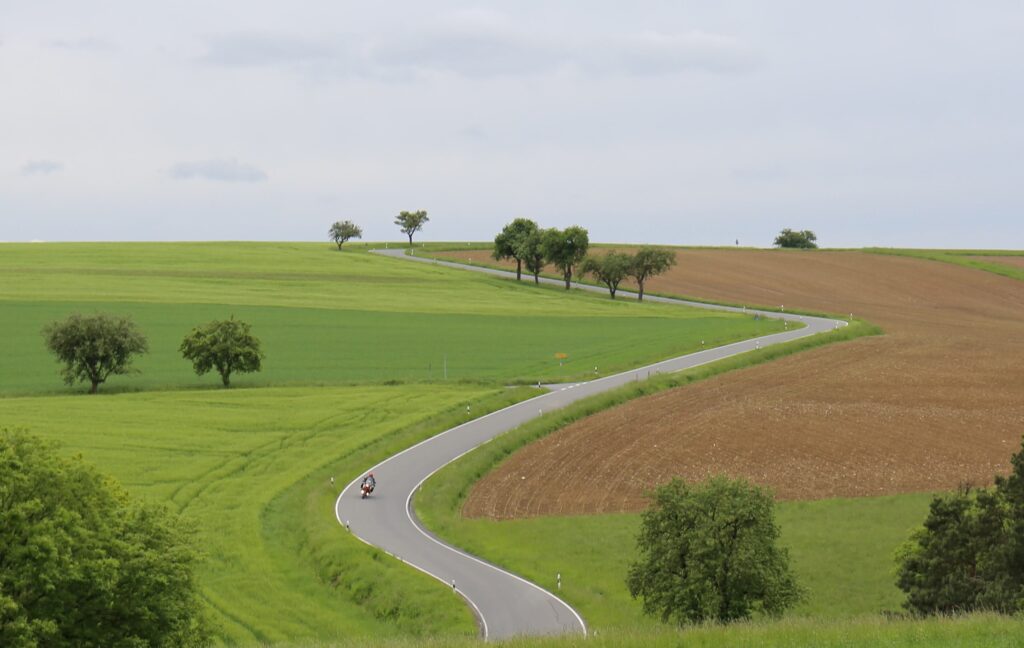
Photo by Brutus
That would describe Brutus and me, all right.
I am also pleased to be able to begin this story in Amsterdam, after the British run, because on that previous attempt to write about Europe, “Singletrack Minds in the Sceptered Isle,” I had stopped at the end of the British travels, promising to pick up the Continental European part later. I never did—but I guess I am now.
And referring back to another theme from a previous story, “Nothing is ever just one thing,” there are infinite degrees of shunpiking. Muddy, lumpy trails through the forest, narrow lanes pinched between hedges or stone walls, and sweeping ribbons of pavement that lay sinuously over hills and valleys—all are a shunpiker’s delight.
Roads no one travels unless they live on them.
Shunpiking in Europe is generally more extreme than in North America, mainly because of the greater number of singletrack roads available. (Though North America has far more unpaved roads.) The other big difference shunpikers enjoy in Europe is the destinations. In North America, it is unusual for a fabulous ride to lead to a fantastic destination, save perhaps in the national parks, but in the Old World, luxurious accommodations with fine restaurants are an attraction in themselves.
So planning ahead is important, and Brutus is a master at it—because he understands that when you are plotting a route, you are tracing your future life across that map. You are truly sowing what you will reap, and those squiggles and dots represent the environment that on a given day you will inhabit, move through, and savor—that you will live.
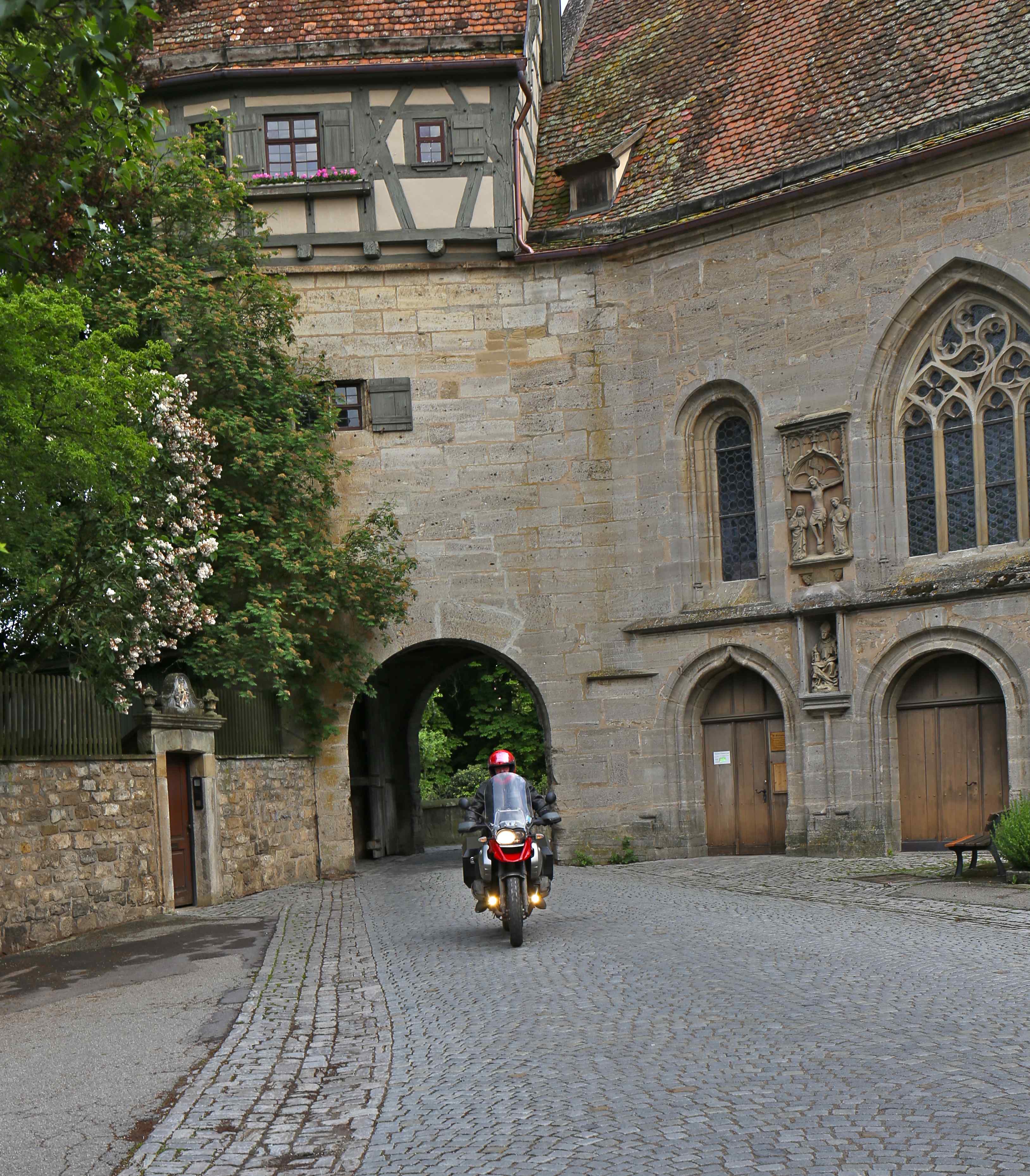
Photo by Brutus
After a full day’s travel through northern Bavaria that we later agreed was Germany’s best motorcycling (as illustrated in all of the previous riding photos), second only to the Alps, Brutus’s researches led him—and thus us—to this picturesque town in Bavaria. Rothenburg is regarded as the best-preserved medieval walled city in Europe, and it is very much a tourist showplace. During World War II, Rothenburg escaped the worst of the bombs and artillery that devastated other German cities only because of one of history’s quirks. A high-ranking American general was aware of the city’s history and beauty, and ordered it spared. (A similar sentiment saved Kyoto, the ancient capital of Japan, and an equally historic and picturesque city. Before the war, an American general had spent his honeymoon in Kyoto, and so aimed the bombers at places like Hiroshima and Nagasaki instead. In a further historical twist, Brutus and I saw busloads of Japanese tour groups in Rothenburg, drawn there because it was the setting for a popular animated series, Sugar the Little Snow Fairy.)

In these times, it seems pointless to expend words and images on a celebrated attraction—interested readers can go see for themselves with a few keystrokes—but the countryside and villages remain the province of the real-time traveler, and so too does what I might call “living history.”
With that in mind, I wish I could simply report that Brutus and I had some “interesting” rides across Germany and Poland, and that the weather was fine.
However, when you travel in places with long and tragic, even brutal, histories, it is impossible not to feel something—a perceived darkness that evokes the “Shadowlands” of the title. Apposite to George Santayana’s chestnut, “Those who cannot remember the past are condemned to repeat it,” is the reality that those who do remember the past are condemned to relive it. Traveling in parts of the world with dark histories, you tend to see shadows everywhere—in this case, shadows of the swastika and hammer and sickle.
In my childhood of the ’50s and early ’60s, World War II was fresh in the world’s memory, and we saw it dramatized constantly, in prime-time shows like “Combat!” and “Twelve O’Clock High,” and even more so in dozens of war movies seen at the Saturday afternoon matinees, and on the weekend double-feature late shows on TV.
As for the Cold War, it was now—the all-pervasive background to my childhood, and fairly terrifying to live through. During the anxious and potentially apocalyptic days of the Cuban Missile Crisis in October, 1962, I was ten, so not much aware of global politics. However, I watched my father prepare an emergency shelter in the basement of our suburban split-level—a pathetic-but-telling attempt at preparation for the nuclear attack everyone feared. In our kitchen, I overheard the neighboring dads discussing the Russians, and how they would surely bomb Niagara Falls because of the hydroelectric generators. Niagara Falls was fifteen miles away.
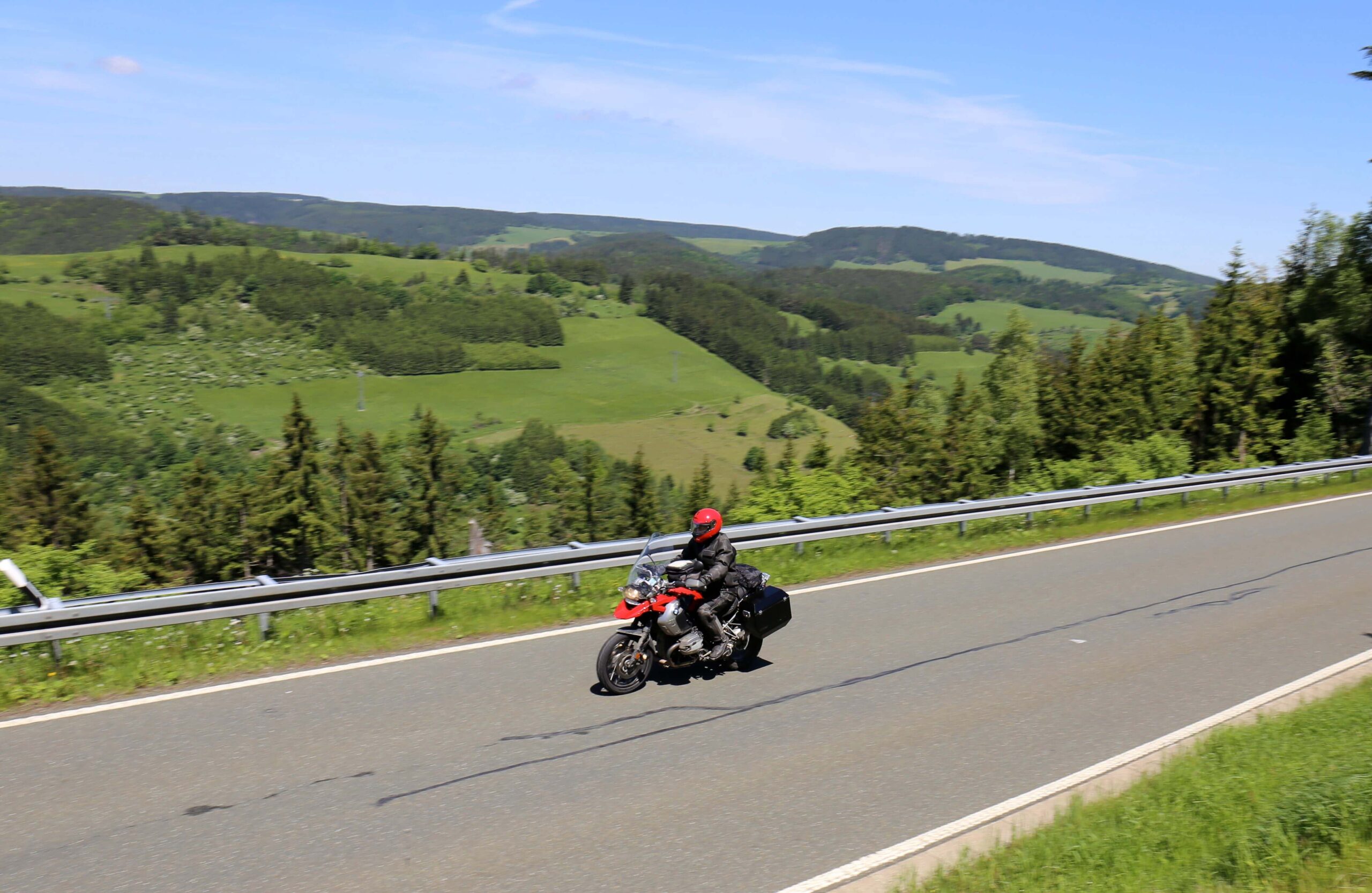
Photo by Brutus
In the early ’90s, just after the Berlin Wall came down, followed by the dominoes of all Eastern Europe, I wrote the lyrics for a song called “Heresy,” about the bittersweet end to all that. I hadn’t even heard the song for maybe twenty years, and I don’t think we ever played it live, but the lyrics and vocal lines were echoing in my helmet all through those rides. One verse particularly addressed the weight under which the whole world had lived—nuclear annihilation, or “Mutually Assured Destruction” (apt acronym).
It seemed—and seems—outrageous that the entire planet endured decades of anxiety, not to mention all the stunted lives in these Shadowlands, under the totalitarian boot-heel, for the sake of some misguided ideology. (Someday, I trust, the same will be said about religion.)
All around this great big world/ All the crap we had to take
Bombs and basement fallout shelters/ All our lives at stake
The bloody revolution/ All the warheads in its wake
All the fear and suffering/ All a big mistake?
All those wasted years
All those precious, wasted years
Who will pay?
George Santayana offered another quote that still resonates loudly in our world today, “Only the dead have seen the end of war.”

From Rothenburg, Brutus and I started out on the “Romantische Strasse”—Romantic Road—which connects some picturesque towns and castles in Southern Germany, ending at Mad King Ludwig’s ultimate fantasy castle, Neuschwanstein. Riding north toward the show in Cologne (German spelling Köln), we enjoyed a few hours of shunpiking, following winding little roads past dark green forests and swollen brown rivers. But, with far to go to work that day, we eventually had to surrender to a lengthy stretch of autobahn. We did not love it.
The inside lane was a solid freight train of trucks traveling at about 60 mph, while the outside lane was much faster, even sometimes “unlimited.” So big Mercedes, BMWs, Audis, and Porsches came racing up from behind at well over 100. Our motorcycles, and especially our tires, were oriented toward sport and adventure riding, and were not comfortable above 90 mph. We were caught between the traffic’s natural flow—pulling out to pass a truck through its turbulent wake, wrestling for control, and at the same time keeping an eye on our mirrors at all times. The road was straight and dull, yet the mood was tense and loud—not our kind of thing at all. But as with American interstates, sometimes it was a price worth paying.
The next morning we awoke on the bus at what appeared to be the usual “motorway services” (truck stop) on an autobahn. However, when I opened the blinds to check out the day’s weather, I noticed unusual details. All around us stood tall metal watchtowers, and the modern Shell gas pumps were sheltered under a vast canopy of much greater age and less sleek design. Old gray and dowdy-looking buildings of poured concrete were painted with large, weathered letters reading “ZOLL.” (Customs.)
With a chill, I realized we were looking at another kind of “walled city” from the past—from another kind of hyper-medieval era, the Cold War. We were on the former East German autobahn near Eisenach, for many years one of only three crossing points by road between the savagely divided parts of the country.
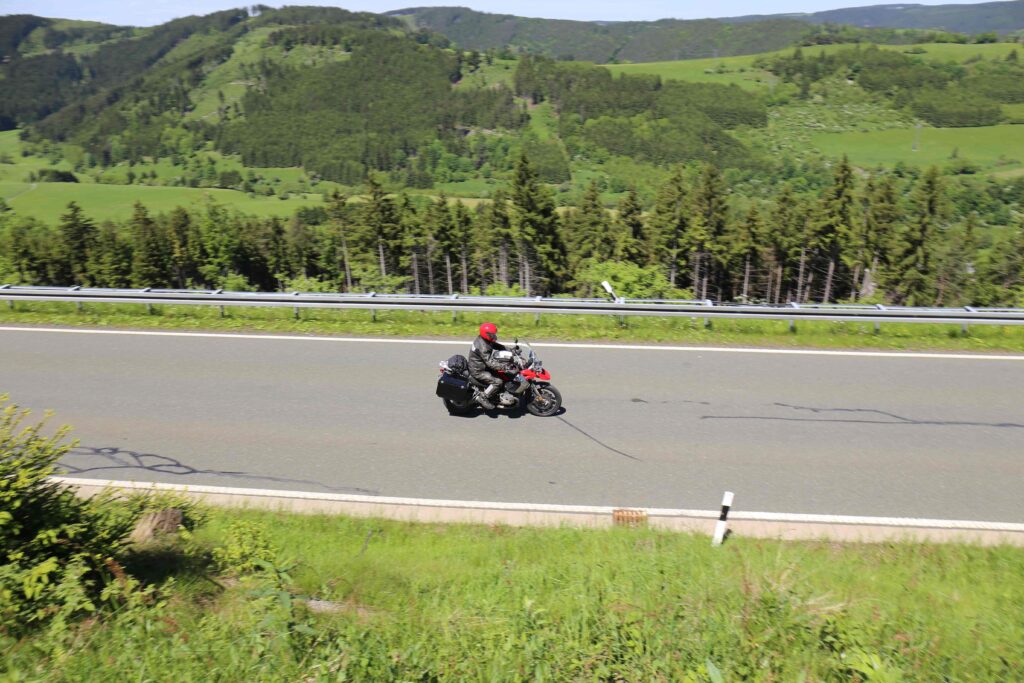
Writing about a time that is nearly unimaginable now, the venerable travel writer Jan Morris observed, “Traveling from west to east through [the inner German border] was like entering a drab and disturbing dream, peopled by all the ogres of totalitarianism, a half-lit world of shabby resentments, where anything could be done to you, I used to feel, without anybody ever hearing of it, and your every step was dogged by watchful eyes and mechanisms.”
Over the next few days, as Brutus and I traveled through the former East Germany and then into Poland, everything I saw was colored with the lenses of that shadowy history—what those places had endured, and what the people who lived there had done, what had been done to them, and what they had been denied.
Again, verses from “Heresy” kept playing in my helmet, as once more I felt the emotions stirred by the sudden fall of Eastern Europe.
(At least three things I never thought would happen in my lifetime: peace in Northern Ireland, the end of apartheid, and the tearing down of the Berlin Wall.)
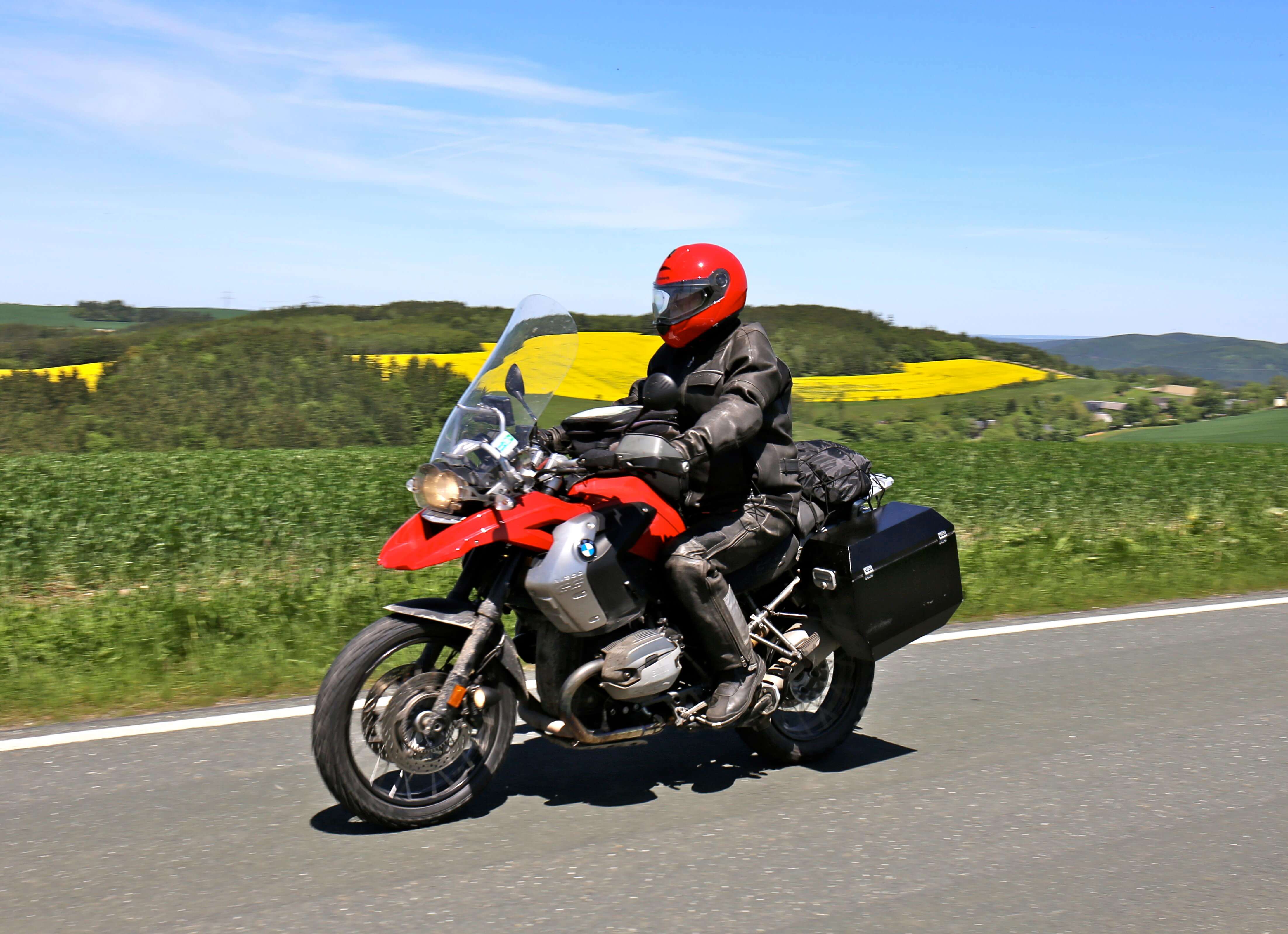
Photo by Brutus
All around that dull gray world/ From Moscow to Berlin
People storm the barricades/ Walls go tumbling in
The counter-revolution/ People smiling through their tears
Who can give them back their lives/ And all those wasted years
All those precious wasted years—Who will pay?
Twenty years later, I still felt that sense of injustice and anger. Because these people are still paying, literally with their lives, while the villains and ideologues who laid them all low were allowed to play hero while secretly commiting unspeakably horrible crimes against humanity—against so many individual humans.
“Everyone is equal,” they insisted—but those few were obviously much more equal than the masses.
Like Prohibition, the rise and fall of communism is sometimes written off as a “Noble Experiment,” but any way you look at it, collectivism is precisely the opposite of noble. (Once I wondered about the fanatics behind both communism and fascism, “Were they evil psychopaths or just misguided morons?” I decided it was a mix of both—the deadliest combination in history.)
Riding through so many backroads and villages in the former East Germany, and spending the night in Dresden, there is no doubt things are better now—yet they still lag behind their compatriots in the former West Germany.
And if the former Karl-Marx-Stadt is now back to Chemnitz, I was still genuinely surprised—even appalled—to ride into the former East Berlin along Karl-Marx-Strasse. Likewise on a previous tour, when Brutus and I crossed out of a ride through Poland at Frankfurt (the secondary one, on the Oder), and my eyes widened to see their main street still named after Karl Marx. These days you don’t see any Hitler or Stalin streets, and Leningrad is back to St. Petersburg, yet it’s a safe bet that no individual in history has been the cause of so much slaughter and suffering as Karl Marx.
(His only competition might be the imaginary ones, the Deities—referred to by Marx and his buddy Friedrich Engels as “the opiate of the masses.” If you ask me, it’s more like the crystal meth of the masses.)
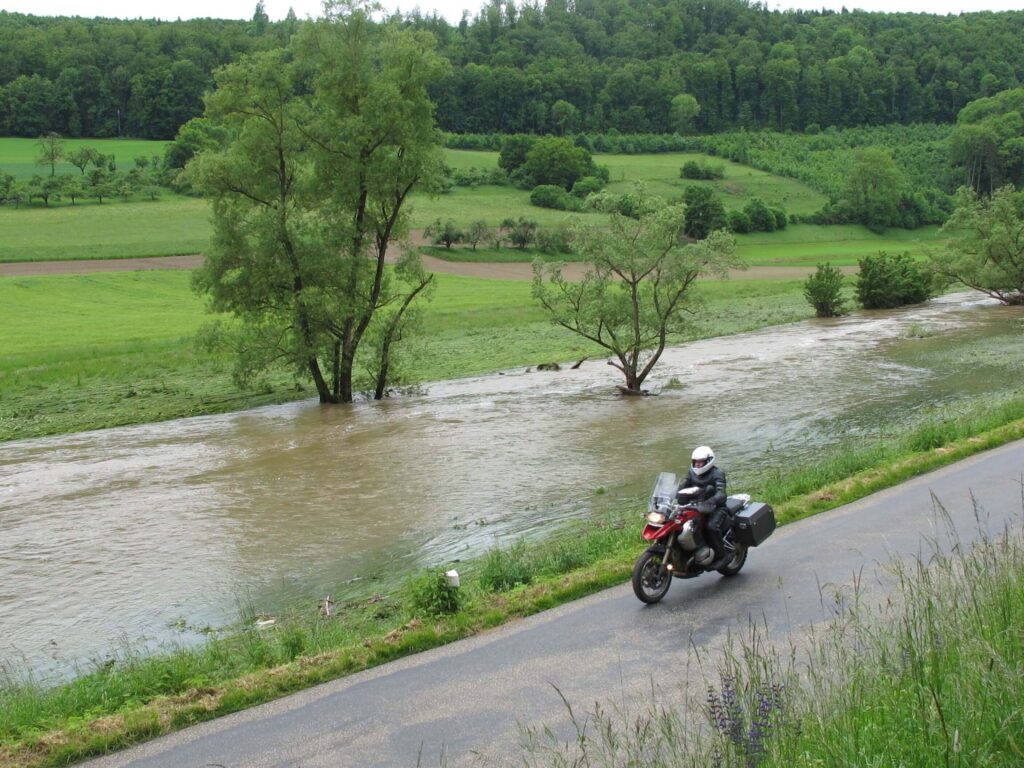
In the spring of 2013, the international media were reporting about the severe floods in Southern Germany, and friend Craiggie wrote to Brutus and me from South Pasadena, California, to warn us about the situation. We were fortunate that our routes were not affected, but riding into Dresden, we witnessed another kind of human unification against a common enemy—great numbers of citizens joining together not to fight against another group of people, but against Nature and “global weirding.”
Through Dresden’s “Centrum,” along the banks of the Elbe River, we rode past many thousands of people—mostly students, it seemed—working in relays to unload, pass, and stack sandbags, from army trucks and even regular delivery vans, to build temporary levees above the pavement. Other people in the streets pushed carts filled with large bottles of drinking water and other emergency supplies. With the river level so high, the bridge arches were far too shallow for the rivercraft to pass beneath them, so the tourboats and barges were trapped between, tied to drowned quays and wharves.
At our hotel, we were told that the city’s flood wall was nine meters high, and the waters were currently at eight-and-a-half meters. We would not be able to park our motorcycles in the hotel’s underground garage, but would have to leave them on the street. (We didn’t mind that convenience—one disadvantage of riding into older European cities is that the parking can often be distant; in Rothenburg, the lot for the Herrnschlösschen Hotel was many blocks away, and we had to have a car pick us up, then take us there again in the morning.)
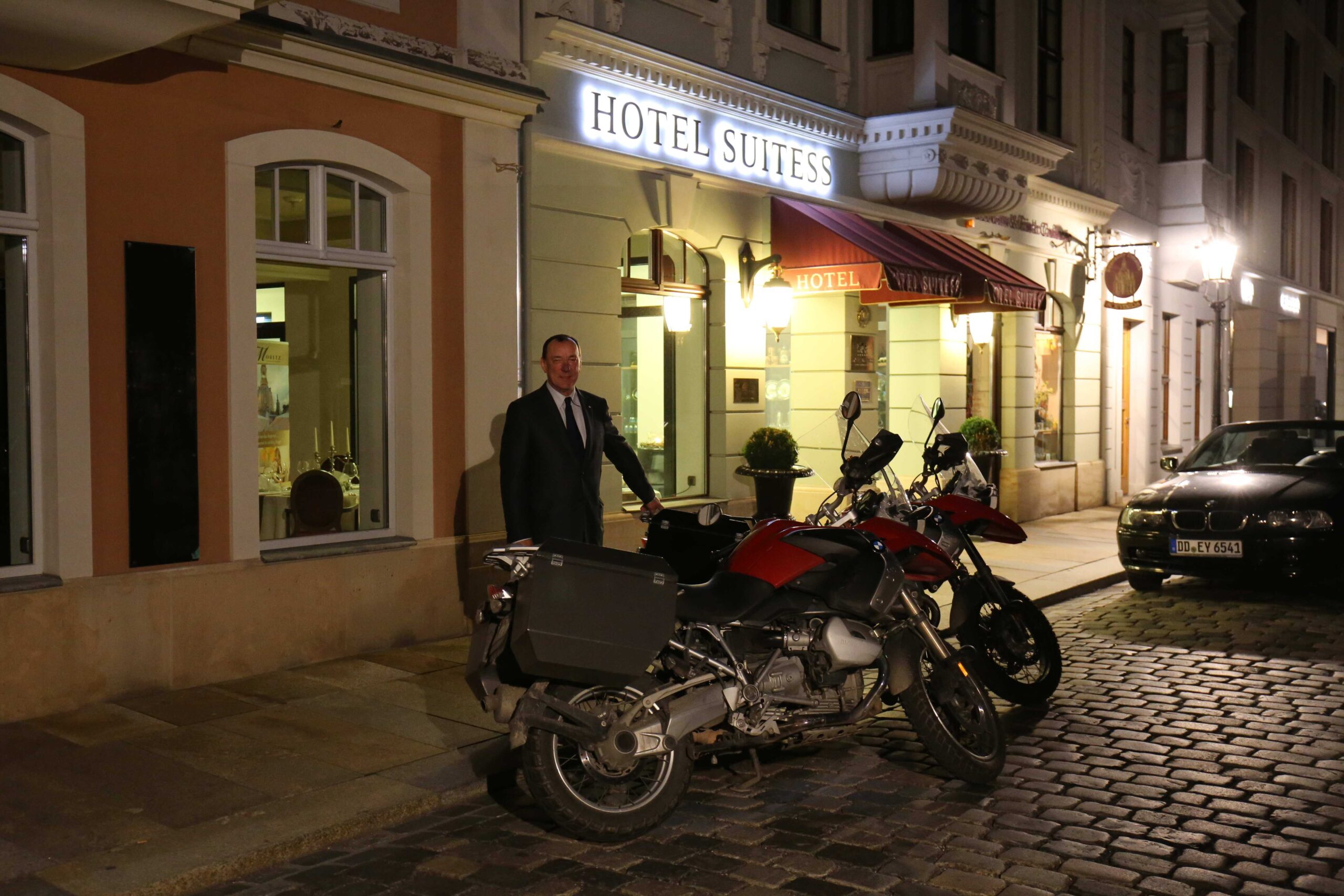
After dressing up for dinner at the hotel’s fine restaurant, Brutus and I took an evening stroll in the city’s vast central area, which was in the process of being redeveloped into something like its former glory. Dresden’s heart seemed less baroque and “stagy” than Munich or Vienna, and less frenetic and edgy than Berlin—more like a plaza in a Southern European city. Sidewalk cafés overlooked a vast cobbled pedestrian area, the surrounding buildings splendidly illuminated, all centered on an enormous cathedral, the Frauenkirche. (It had lain in ruins, as a monument, from 1945 through the Soviet era, until its restoration in the early 2000s.)
We sat at one of the outdoor cafés and enjoyed a cognac, and marveled at how the city had rebounded not only from the Soviet doldrums, but from total annihilation in the infamous Firebombing of Dresden. Near the end of World War II, in February, 1945, British and American aircraft dropped thousands of tons of explosive and incendiary bombs on Dresden. The entire central city was destroyed, and 25,000 civilians were killed.
Once again, interested readers are invited to look further into that story, which is not without controversy (as usual, victors write the history), and especially to view some of the harrowing photographs taken after the bombing. Kurt Vonnegut’s novel Slaughterhouse-Five (1969) evokes his experience in Dresden then, as a prisoner of war, and in the introduction to a later edition of the book, he wrote, “The Dresden atrocity, tremendously expensive and meticulously planned, was so meaningless, finally, that only one person on the entire planet got any benefit from it. I am that person. I wrote this book, which earned a lot of money for me and made my reputation, such as it is. One way or another, I got two or three dollars for every person killed. Some business I’m in.”

Photo by Brutus
The second verse of “Heresy” describes the rise of Eastern Europe, and especially places like Dresden, from both the ashes of war and the Soviet concrete and rust.
All around that dull gray world/ Of ideology
People storm the marketplace/ And buy up fantasy
The counter-revolution/ At the counter of a store
People buy the things they want/ And borrow for a little more
All those wasted years/ All those precious, wasted years
Who will pay?
In 1991, just a year or so after Reunification, I traveled through a good bit of the former East Germany, with eyes wide open. It absolutely was that “dull gray world” I described in the first verse of “Heresy,” and the hints of returning color stood out almost garishly—cheap plastic articles in shop windows, fresh coats of paint on scattered houses in the villages, and brightly-colored older Volkswagens and smaller BMWs in used-car lots among the homely, smoky Trabants. (An East German make universally acknowledged as one of the worst cars ever made, with its two-stroke engine and body panels of “Duroplast”—not much stronger than cardboard—Trabants are absent from the roads now, and will soon exist only in museums. As artifacts—not art!)
By 2013, almost twenty years later, the transformation of East Germany was all but complete. They still lagged slightly behind the West in development and prosperity, but the gap is closing, and most clearly the flair is back in life again.
But how awful to reflect that fully two generations of people there—the people, middle-aged and older, that I saw on the roads all day, and often waved to in passing—had to endure that repression, had to have their lives so impeded, and for the young, such a limited prospect for their futures.
The chorus of “Heresy” offers what is perhaps the necessary resignation,
Do we have to be forgiving at last?
What else can we do?
Do we have to say goodbye to the past?
Yes, I guess we do
